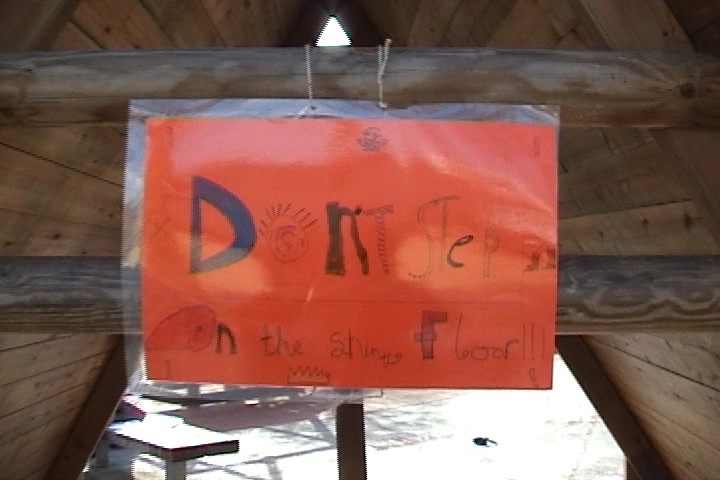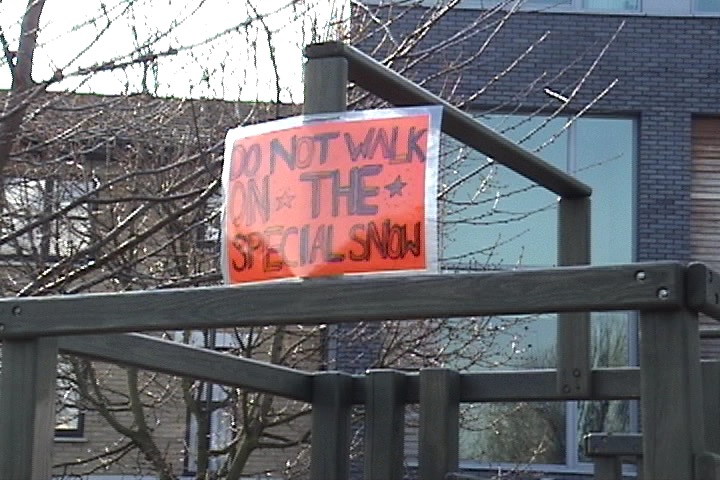Stories EverYwhere!
Coordinated By: The Eastside Educational Trust
Funded By: Creative Partnerships
Date: 2006
Participant Age Range: 1st-6th graders, with some sessions also including parents/guardians
Stories Everywhere! was a site-specific writing project I produced — in collaboration with writer and artist Ceri Buck — with the students and teachers of Hermitage Primary School in Wapping, London. Playing on the theme "public writing", we facilitated 3 x week-long workshops for Years 3, 3/4, and 4 that approached storytelling as a means by which the children could explore their environment and communicate their understanding of the world they live in. Each workshop invited students to write site-specific stories, which were then published within the school via a large map, signs and graffiti in the school playground, and a hung installation of 20 life-size paper silhouettes. At the end of each workshop, each group worked together to give a presentation about their project at a school-wide assembly.
Over the course of the workshops students were introduced to various story-telling techniques — including telling a 1-word story, 1-line story, and listening to and re-telling a partner's story — and were provided with visual models [for example, a 'story mountain' or timeline] and sample stories to help them organize their writing. Working through multiple drafts of a story, peer editing, and references like a Thesaurus were also introduced as important tools to aid the writing process.
YEAR 3: MAPPING
The aim of this workshop was for each student to write a site-specific story set in one area of the school — the corridor, the main hall, the dining hall, or the entrance — using words found in the chosen space. These stories were then assembled into a 'story map' of Hermitage Primary School, which was put on display in the school.
As a starter exercise, the students studied different types of maps, and drew their own maps of the Year 3 classroom. These classroom-maps were then covered with a sheet of tracing paper, onto which the students wrote down all the words they could find in the room, copying each word over its proper location on the map. Each student created a word-portrait of the classroom!
A more involved version of this exercise followed, with the students working on maps that showed the whole school. Groups of students were led around the school to collect words as they had done in the classroom. Each student then chose his/her favorite collection of words — from the entrance, from the corridor, from the main hall, or from the dining hall — and used these words to write a story.
After writing their stories, the students lastly worked together to create a giant map of the school... complete with key, compass rose, logo, and title. Each student copied a final draft of his/her story onto a large, colored index card, which was then laminated and attached to the story-map with Velcro. This story-map was then presented to the school and hung in a corridor outside the Year 3 classroom.
YEAR 3/4: CHALK-GRAFFITI & SIGNS
For this workshop students worked in pairs to write site-specific, fanciful anecdotes set in the school playground. Each pair also designed a sign on which they wrote an instruction which had something to do with their anecdote.
In preparation for some outdoor writing, the students boosted their descriptive vocabulary by brainstorming all the different words they could use to communicate their five senses. After this brainstorming, the students were placed in separate spots around the Year 3/4 classroom — under and on top of tables, on a bean-bag, next to the sink, even among the coats! — and asked to write detailed 5-sense descriptions of where they were sitting.
Next the students were taken outside to do some site-specific research for their anecdotes. Each pair chose a location in the playground where they wanted to set their anecdote and, writing in that location, they described what it was like to be there in as much detail as they could. Back in the classroom, these descriptions were the beginnings of the students' anecdotes.
Once the anecdotes were written, the students explored how they could present them visually. They looked at concrete poems for inspiration, and then — using a typed version of their anecdote — each pair cut out the separate lines of text, arranged the lines to make a picture of something in their story, and pasted them onto A3 sheets of paper. They then used these A3 'plans' to chalk their stories across the school playground!
Lastly, the students wrote an instruction that related to some detail they'd written about in their anecdote, and made this instruction into a colorful sign. These signs were laminated and hung next to the stories on the playground for the whole school to see!
YEAR 4: SELF-PORTRAITS AS OBJECT & PLACE
For this workshop each Year 4 student wrote a 'Self-Portrait as Object' and a 'Self-Portrait as Place'. Students were invited to bring in objects that meant a lot to them, or represented something about them. As a group, the students shared their objects, explaining how they had came by them and why they considered them to be special. Then, using spider diagrams to organize their words, each student wrote a detailed description of his/her object. When these diagrams were complete, the students circled all the adjectives they'd used to describe their object... that also described them as an individual! Working with these resemblances and a writing model we provided, the students wrote a 'Self-Portrait as Object'. Photocopy "prints" were made of all the 3D objects, and each student wrote a final draft of his or her self-portrait on the back of their print.
The 'Self-Portrait as Place' also began with group sharing. Sitting in a circle, students were asked to close their eyes and visualize the place where they felt most comfortable, most at home, most themselves. Each student then described his/her place to the rest of the group. Next, they were asked to organize their thoughts on a timeline, answering the following questions:
- Where/what is your place?
- What is your place like?
- Why do you feel at home there?
- Describe one event you experienced in this place...
- What might this event/place tell someone about you?
While the students worked on their second self-portraits, we took them aside in groups and traced their silhouettes onto thick paper. The silhouettes were then cut out, each student copied the final draft of their 'Self-Portrait as Place' onto one side of their silhouette, and then colored/decorated the other side. Finally, the finished silhouettes were hung in the school Den for one week as an installation, and invitations to visit the exhibition sent to all the other classes and staff of Hermitage Primary School!
Beyond the Workshops
One of the aims of Stories Everywhere! was to establish long-term active benefits for Hermitage Primary School — including follow-up workshops with the teaching staff, with the Year 3, 3/4, and 4 classes that were the focus of the project, and with the remaining Years 1-6 not directly involved in the initial three workshops.
Ceri Buck and I worked with the teaching staff to share the creative techniques we employed in our workshops. Then we revisited the Year 3, 3/4, and 4 classes, and collaborated with them to create illustrated encyclopedias of imaginary worlds that the students could continue to use as classroom resources and inspiration for further storytelling. With Years 1-6, we facilitated mini-workshops introducing the students to a variety of story-telling games. All these sessions were organized to ensure each group would be involved in sustaining the creative work instigated by the project.
Lastly, parental involvement was welcomed at all stages of the project — with parents invited to support and participate in the main workshops, and asked to contribute family stories to inspire the children’s storytelling. A special parent-only workshop was also scheduled for parents to tell and record their own stories. As Stories Everywhere! also purposefully integrated opportunities to explore and celebrate the cultural heritage of the school's students, 86% of which are Sylheti, parents were encouraged to tell their stories in both English and/or Sylheti.










